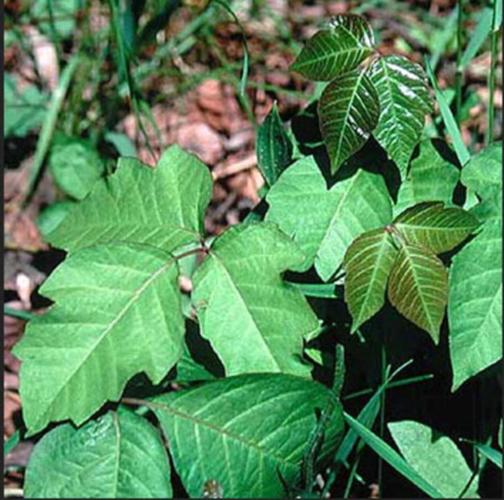Anyone cleaning out overgrown areas or even just weeding should beware. Poison ivy (Toxicodendron radicans) may be growing among the plants you are handling. It pays to be able to identify this plant, avoid it and know what steps to take to get rid of it.
Poison ivy is a tall climbing vine that is leafless in winter. The deciduous foliage turns red in fall before it drops. As it climbs tree trunks, wood fences or other flat structures, the stem produces many small roots that cling to the surface. This gives the vines a hairy look that is a good identifiable characteristic of poison ivy in case you can’t easily see the leaves.
Plants are very common along fences, at the base of trees and seedlings are often found in garden beds.
Poison ivy has a characteristic compound leaf consisting of three leaflets (so the saying, "Leaves of three, let it be"). The leaflets are 2 to 4 inches long and dull or glossy green with pointed tips. The middle leaflet is generally larger than the two laterals.
The margins of the leaflets are variable, appearing irregularly toothed, lobed or smooth. The leaves are arranged alternately on the stems. Young foliage is often shiny or oily looking with a reddish tint.
Mature poison ivy vines growing in trees produce flowers and clusters of white fruit, which are readily eaten by birds. The birds spread the seeds through their droppings, creating the wide occurrence of this plant.
New seedlings of poison ivy are easily overlooked. They may have a reddish tint to their foliage and will appear upright. As they get older, they will begin to vine and grow up nearby shrubs or trees. It is easy to come into contact with young poison ivy seedlings when weeding flower beds, so you need to be observant.
Preventing rashes
The agents in poison ivy responsible for causing the dermatitis are oils called urushiol. Urushiol is found in every part of the plant, including the leaves, stems, flowers and even pollen. It can survive burning. If poison ivy is burned, contact with or breathing of the smoke would be dangerous for people who are allergic.
A significant portion of people are allergic to urushiol, and sensitivity can change over time. Just because you were not allergic to poison ivy as a child does not mean you are not allergic as an adult.
It is best to avoid poison ivy altogether, but if you do realize you have come into contact with it, promptly washing may reduce the reaction. Wash with running water and a degreasing dishwashing liquid (such as Dawn) or soap and plenty of water will remove the urushiol oil. Special cleansers are available at local drugstores (generally in the section with calamine lotion, a common treatment for poison ivy rashes), and you might want to keep these on hand if you have had problems in the past. Lotions are also available that, when applied to the skin beforehand, protect you should contact occur.
Controlling the vine
In controlling poison ivy, one of the most important things to do is to periodically check your landscape carefully for seedling or vines. Look for the three leaflet leaves in out-of-the-way areas, under shrubs, along back fences and by trees.
Three methods can be effective in eradicating poison ivy in landscapes.
BY HAND: The first is hand pulling or digging out when the soil is moist, getting out as much of the roots as possible. Use long gauntlet rubber gloves available at hardware stores or dishwashing gloves when handling the vines. Place the plants into a plastic bag, seal it (in consideration for trash collectors) and throw it away. Be sure to wash your gloves thoroughly with soap and plenty of water after handling poison ivy.
SPRAYING WITH SYSTEMIC HERBICIDE: The second is to carefully spray the foliage with a systemic herbicide. This is only possible when the spray will not get on the foliage of desirable plants. If needed, nearby desirable plants can be covered with plastic sheets or bags to protect them while you do the spraying. Be sure to wet the foliage of the poison ivy vine thoroughly with the herbicide solution.
Systemic herbicides are absorbed by the foliage and enter the plants circulatory system, which sends the material into the vine's roots, killing them as well. Glyphosate (Eraser Grass and Weed Killer, Hi-Yield Killzall and other brands) or triclopyr (Brush-B-Gon, Brush Killer, Cut Vine and Stump Killer and other brands) are commonly recommended for poison ivy control.
Herbicides that contain a combination of dicamba (banvel) and 2,4-D also work well. Once the vine dies, it may be removed. Note: The dead leaves still contain the urushiol and should be handled cautiously with gloves.
CUTTING THE VINE: The third method is for vines growing up in trees or intertwined in shrubs the landscape. Spraying the vine foliage is not practical in these situations because of the potential to injure desirable trees and shrubs. Poison ivy control in sensitive areas can best be achieved by the cut vine method.
Cut off the vine a few inches from the ground with loppers or hand pruners and immediately treat the freshly cut surface of the stump with the herbicide triclopyr. The vine in the tree or shrubs will die because it has no root system. The treated stump will die because the herbicide gets absorbed by the freshly cut surface and translocates to the roots. Applying the herbicide to the fresh cut is necessary because it prevents the stump from resprouting. This method is very effective and may be used any time of the year.
Getting poison ivy off your property will probably take repeated herbicide applications. Older vines in neighboring yards may continue to drop seeds in your landscape. Watch out for this unwelcome plant and be prompt and aggressive in your efforts to control it.



